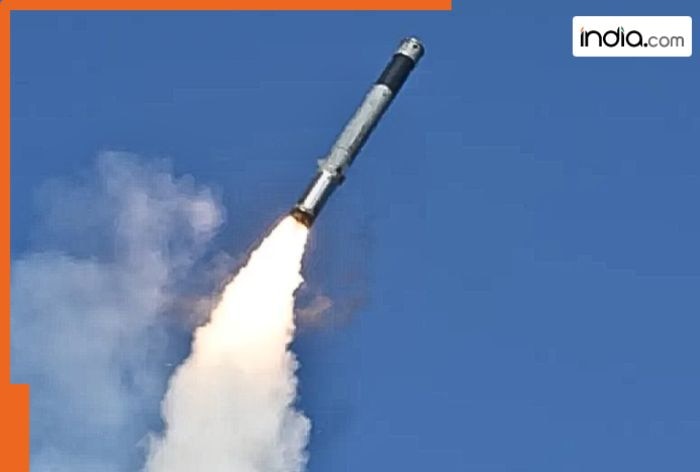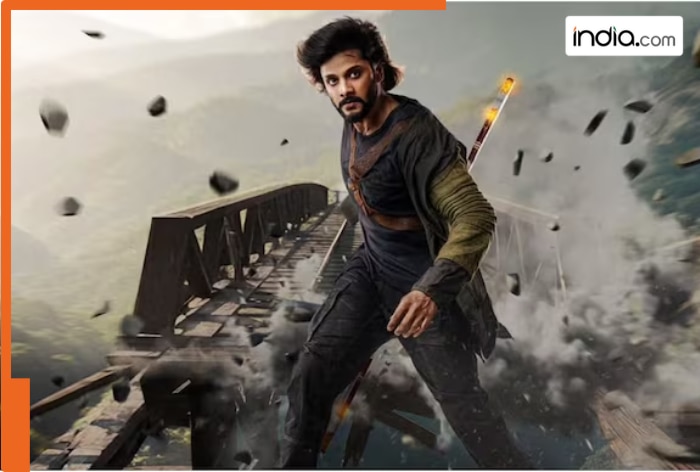
How a homegrown ‘practice target’ is revolutionizing India’s defense training and breaking our dependence on expensive foreign systems.

Picture this: A missile screaming through the sky at speeds reaching Mach 2.5 (850 meters per second), zigzagging unpredictably just 12 feet above the ocean waves. But here’s the twist—this isn’t an enemy weapon. It’s India’s own creation, designed not to destroy, but to train our forces to defend against the real threats of tomorrow.
Meet STAR—the Supersonic Target missile that’s quietly revolutionizing how India prepares for modern warfare.
What Exactly is STAR?
Think of STAR as the ultimate sparring partner for our military. Just like boxers practice with skilled opponents to sharpen their reflexes, our Navy and Air Force need realistic targets to practice intercepting supersonic missiles. STAR can achieve speeds ranging from Mach 1.8 to 2.5 (612 to 850 meters per second), mimicking the behavior of modern anti-ship missiles that enemies might use against us.
This ingenious system operates across a wide altitude range from 100 meters to 10 kilometers, with an operational range of 55 to 175 kilometers. With flight times spanning 50 to 200 seconds, it can simulate various attack scenarios—flying as low as 12 feet above water to mimic modern sea-skimming missiles, or plunging from over 30,000 feet to replicate high-altitude attacks. It’s like having a shape-shifting practice dummy that can replicate any missile threat our forces might face under various environmental and operational conditions.
Why This Matters for India
For years, India has faced a troubling reality: our military had to train against imported, expensive target systems, or worse, rely on theoretical simulations. Under the ‘Atmanirbhar Bharat’ push, we have gone from heavily relying on imports to rolling out impressive indigenous systems. STAR represents a crucial step in this journey.
The Cost Factor: Unlike combat missiles, STAR doesn’t aim to destroy enemy targets—instead, it mimics the enemy, helping our forces practice interception in real-time. This reusable system is far more cost-effective than importing foreign alternatives or using actual missiles for training.
The Training Revolution: Imagine teaching someone to drive using only a computer simulation versus actual road practice. STAR provides realistic training simulations that will equip Indian Navy crews with the skills and experience necessary to counter modern anti-ship missile threats, preparing them for agile, fast-flying enemy missiles under real combat conditions.
The Technology Behind the Magic
STAR utilizes a two-stage propulsion system—a booster rocket for rapid acceleration, followed by a Liquid Fuel Ramjet (LFRJ) engine that propels it at supersonic speeds. This isn’t just clever engineering; it’s a technological breakthrough that puts India in an elite club.
The liquid fuel ramjet technology, also being developed for the Astra Mk3 air-to-air missile program, offers advantages like extended range and endurance compared to traditional rocket motors. By mastering this technology, India is laying the groundwork for future indigenous supersonic weapons.
More Than Just Practice: Multiple Variants for Maximum Impact
Here’s where it gets exciting: DRDO is developing two main variants of STAR, each designed for specific strategic needs.
Air-Launched Version: This variant is being developed for fighter platforms such as the LCA Tejas for air-to-air and air-to-ground combat roles. It may support Anti-Radiation and Anti-AWACS missions by offering target realism and engagement readiness at tactical range. Airborne deployment expands STAR’s reach and utility during joint-force deployments like Operation Sindoor and rapid response simulations.
Ground-Launched Version: Adding booster stages enables STAR to launch from ground vehicles or static platforms, providing strike training with longer endurance. This ground-based version serves as a versatile tool for simulating surface-to-surface or shore-to-ship supersonic missile attacks. The best part? Commanders can deploy STAR across rugged or remote locations without needing expensive setup or launch infrastructure—just load it on a truck and you’re ready to train anywhere.
This means our “practice missile” could evolve into a real defensive weapon, capable of taking out enemy radar installations and surveillance aircraft, while also providing flexible training options for different combat scenarios—talk about getting maximum bang for your buck!
Breaking Free from Dependence
The strategic implications are enormous. As per G Satheesh Reddy, India achieved complete self reliance in missile technology, and STAR is a shining example of this capability. Instead of waiting months for foreign suppliers or paying premium prices for imported training systems, India can now produce its own.
This acquisition underscores India’s commitment to the Atmanirbhar Bharat initiative, prioritizing indigenously designed, developed, and manufactured systems. Every STAR missile built strengthens not just our military readiness but also our domestic industrial base.
Where We Stand Today
As of May 2025, the STAR Missile project has entered Phase-III development, with DRDO engineers conducting full-system integration and advanced validation trials. This represents a significant milestone in the program’s progress toward operational deployment.
Fabrication of key components, including rocket motor casings and nozzles, has been completed, and the system is undergoing extensive flight testing to evaluate its accuracy, reliability, and overall performance. Engineers are integrating key subsystems—propulsion, guidance, and control—into a full-scale prototype, subjecting it to simulated combat conditions.
This isn’t just another defense project—it’s a symbol of India’s growing technological confidence. DRDO’s progress with the STAR Missile underscores its growing prowess as a missile powerhouse, ensuring that global technology control regimes can no longer hinder India’s ambitions.
The Bigger Picture
STAR represents something larger than a single missile system. It embodies India’s transformation from a defense importer to a self-reliant military power. India’s defence is transforming, with 174 per cent production growth, rising self-reliance, and indigenous systems driving Atmanirbhar Bharat forward.
The versatility of STAR allows it to simulate threats across air, land, and naval domains, making it a valuable asset for the Indian Navy, Army, and Air Force. This adaptable nature ensures DRDO can modify STAR to fulfill training and strike simulation roles across the tri-services.
When our naval officers and air force pilots train with STAR, they’re not just learning to intercept missiles—they’re preparing to defend a nation that’s increasingly confident in its own technological abilities. They’re training with equipment that bears the proud label “Made in India.”
Looking Ahead
As STAR moves toward operational deployment, it signals a new era for Indian defense. Our forces will be better trained against realistic supersonic threats, our costs will be lower, and our strategic autonomy will be stronger. The air-launched variant promises to give India crucial capabilities in neutralizing enemy airborne warning systems and radar installations.
Most importantly, we’ll have proven once again that when India sets its mind to solving a problem, we don’t just find a solution—we create one that’s better and more affordable than what anyone else offers. The STAR Missile not only promises to be a cost-effective alternative to existing systems like BrahMos but also holds potential for broader applications, including strike simulation roles across the tri-services.
The next time you hear about supersonic missiles in the news, remember STAR—the unsung hero that’s making sure our defenders are ready for whatever comes their way. In a world where military preparedness can mean the difference between peace and conflict, having a homegrown system like STAR that can replicate agile, fast-flying enemy missiles under various conditions isn’t just smart—it’s essential.
India’s STAR missile: proving that sometimes the best defense is a great practice partner.
———–E.O.M
(Girish Linganna is an award-winning science communicator and a Defence, Aerospace & Geopolitical Analyst. He is the Mana.ging Director of ADD Engineering Components India Pvt. Ltd., a subsidiary of ADD Engineering GmbH, Germany.)
Topics





